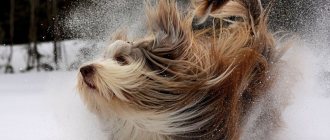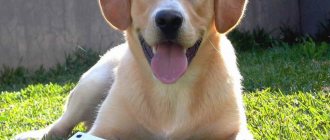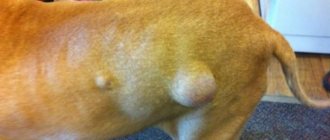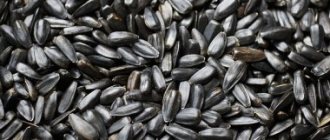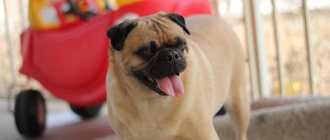Spitz, like all long-haired dog breeds, are susceptible to dandruff. One of the main reasons is seasonal molting (spring-autumn). During this period, the dog’s skin along with the undercoat is renewed. If after the shedding season your Spitz's dandruff goes away, then there is no cause for concern. When peeling skin is a constant companion of a dog, and the pet itches regularly, it is necessary to identify the cause of the condition and eliminate it. In some cases, the help of a veterinarian may be necessary. The doctor, depending on the cause, will prescribe appropriate treatment.
Causes
The appearance of dandruff can be caused by two types of reasons: non-dangerous, in which dandruff can be eliminated using ordinary cosmetic procedures, and dangerous, when the dog needs to be shown to a specialist. Non-dangerous reasons include:
- molting;
- dry skin in Spitz during the heating season;
- poor diet with a lot of chemical additives;
- use of inappropriate cosmetics (shampoos, etc.);
- after stress.
Such causes can be eliminated using massage with a soft brush. Also, against the appearance of dandruff, veterinarians recommend introducing vitamin A into the dog’s diet, both in pure form and in the form of products with a high content of it. Chemical food additives should not be used.
Reference! Bathing a Spitz is a very important and responsible process. If you choose the wrong cosmetics, an allergic reaction, manifested in the form of dandruff, is possible.
Therefore, you should use a special medicated shampoo and moisturizing conditioner. It is necessary to bathe your pet at least once a month, thoroughly combing the fur before starting the procedure.
The second type of reasons - dangerous - include:
- the presence of fleas, hair or subcutaneous mites;
- diseases of the endocrine system;
- problems with hormones;
- food allergies;
- oncology;
- diabetes;
- liver problems.
If massage and water treatments do not eliminate dandruff, then most likely the cause of its occurrence belongs to the second type.
In this case, it is necessary to urgently show the Spitz to a veterinarian, who will determine the exact cause of dandruff and prescribe effective treatment. Attention! Dandruff in Spitz dogs is often accompanied by an unpleasant odor, itching, rash, and even hair loss. If such symptoms occur, you should immediately consult a specialist.
Differential (ruling out) diagnoses
Parasitic disease cheyletillosis caused by ticks Cheyletiella spp.
, and seborrhea may have a similar clinical picture. Cheyletiella are found in cats, rabbits, and dogs. Infection occurs through contact or through the environment. Cheyletiella live in the upper layers of the skin; females lay eggs and attach them to the hair. Adult mites have a whitish tint, and are similar to the scales of dry seborrhea; due to their ability to move along the fur, these parasites are sometimes called “walking dandruff”. With cheyletillosis, dogs develop itching and flaking of the skin, especially pronounced in the back area. For treatment, drugs against ectoparasites and antiseborrheic shampoos are used.
Whitish scales on the fur of a dog with cheyletillosis are “walking dandruff”, an adult mite Cheyletiella spp
. (Photos courtesy of V.V. Kulik, veterinary dermatologist at the Biocontrol clinic).
Ichthyosis has similar clinical manifestations. This is a rare congenital condition that occurs in various breeds of dogs, and is especially common in Golden Retrievers, Jack Russell Terriers, West Highland White Terriers and Cavalier King Charles Spaniels. It usually occurs in a mild form, but some owners note the development of large, soft, whitish or grayish scales on their pet’s body, which fit more tightly to the skin and are more difficult to comb off than with dry seborrhea. In some cases, dogs develop bacterial folliculitis (purulent inflammation of the hair follicles), which causes itching and, accordingly, the veterinarian may confuse this condition with an allergy.
Allergic reactions, including food allergies, are also one of the differential diagnoses. As a rule, lesions on the skin are similar to oily seborrhea. Allergies cause similar skin lesions, but, unlike seborrhea, allergic reactions are immediately accompanied by itching.
If such a clinical sign of skin diseases as itching is present, the veterinarian may prescribe Apoquel to the animal. Apoquel is one of the medications that relieves symptoms of itching and inflammation in dogs due to allergic reactions. It successfully eliminates the symptoms of any allergy, beginning to act on average 4 hours after giving the tablet. The drug is approved for long-term use and is well tolerated by dogs. Apoquel relieves swelling, redness and itching of the skin, including in the external auditory canal. Unlike other drugs aimed at eliminating the symptoms of an allergic reaction, this drug does not affect the results of clinical and diagnostic tests that will be performed at an appointment with a dermatologist.
Author: Natalya Valentinovna Pashintseva, morphologist at the Biocontrol veterinary clinic, candidate of biological sciences.
Treatment
When the cause of dandruff has been established, treatment prescribed by your doctor can begin.
Dryness
If your Spitz has normal dry skin, your doctor may recommend combing your pet with a soft brush, after moistening the coat. This kind of massage improves blood flow to the skin.
In addition, you need to wash off the dandruff with special medicated shampoos, but you should not wash the dog too often. As a result of these simple steps, the Spitz's coat will become thick and soft again, and dandruff will disappear.
Shedding
If dandruff occurs during the dog's shedding, special shampoos containing salicylic acid will come to the rescue. They reduce the amount of dandruff and ease the shedding period.
Your veterinarian may also recommend a special preparation, Essential 6 spot on dermoscent. Made in France, it perfectly moisturizes the dog's skin and reduces flaking.
Stress
Dandruff in a Spitz can also appear after experiencing stress. In this case, you should just wait until the dog calms down and then the dandruff will go away on its own.
Food allergies
In case of food allergies, it is enough to switch the Spitz to another food that does not contain harmful additives and flavor enhancers. If your dog eats natural food, you should carefully review its diet and identify foods that cause allergies.
Fleas, ticks and other parasites
If parasites are present, the doctor will prescribe special medications to help destroy them. All veterinarian recommendations must be strictly followed. It is also very important to sterilize all things that the Spitz has come into contact with. These could be his toys, a comb, a sleeping place.
Poor nutrition
Very often, dandruff occurs due to an irrational (unbalanced) diet. In this case, the diet is completely revised together with the veterinarian and various products containing useful macro- and microelements are added to it, and food containing vitamin A is also required.
A dog's drinking habits play an important role in nutrition. It is necessary that your Spitz always has fresh, clean water. It is not recommended to give tap water.
Serious illness
If the doctor discovers a serious illness, treatment must begin immediately. Self-medication in this case, as well as an incorrect diagnosis, can aggravate the situation.
What is dandruff in dogs and what does it look like?
Dandruff on a dog's coat looks like small scales of a light shade, dry or, conversely, greasy. These are dead particles of the epidermis, the top layer of skin. A certain amount of them is normal: skin cells are constantly renewed, and dried dead particles flake off from the surface. Sometimes dandruff appears on a dog’s body during shedding: if it disappears after it and does not cause discomfort to the animal, there is most likely no problem. However, a person should be wary if:
- dandruff appears not only when the animal sheds;
- peeling is very active, and a large number of scales are visible to the naked eye;
- the surface affected by dandruff is constantly increasing and covers large areas of the body;
- areas of peeling are localized and located in the tail area or on the back;
- you notice black scales;
- the animal shows discomfort and often itches;
- For some reason, the dandruff moves, the particles are oval in shape and are firmly stuck to the hair;
- The hair on the affected areas began to fall out and climb.
Puppies
Spitz puppies have thinner skin, so they require more careful grooming. If dandruff appears, you need to wash the puppy every three days and then thoroughly moisturize the coat. Shampoo must be used medicinally to effectively remove skin secretions.
Just in case, you can treat the puppy’s fur with a special preparation called Stronghold. It destroys many types of external parasites and is safe for the animals themselves, as well as their young. It is very important to follow the dosage of this product and use it according to the attached instructions.
If, in addition to dandruff, the puppy has other serious symptoms (severe itching, unpleasant odor, baldness), you should immediately show the dog to a specialist to prescribe more appropriate treatment, taking into account the characteristics of the pet.
Important! Don't delay visiting the veterinarian! Who else, if not him, will determine the exact cause of dandruff and prescribe the correct treatment. Spitz puppies have thinner skin and a weaker immune system, so they are more susceptible to various types of parasites and diseases.
Why you should see a veterinarian
If your dog has dandruff, check with your veterinarian about what to do. Due to the wide variability of causes, a number of studies must be completed to make a correct diagnosis:
- blood analysis;
- allergy tests;
- skin scraping;
- Wood's lamp test;
- tests for bacteriological and mycological culture;
- Ultrasound and X-ray.
Self-medication should be avoided, since erroneous diagnosis will only worsen the patient’s condition, complicating the work of doctors. After receiving the test results and collecting an anamnesis, your four-legged pet will be given a treatment based on the cause of its disease.
Pregnant or nursing
For pregnant or lactating Spitz bitches, the features are almost the same as for puppies. Their immunity is also very weakened and therefore they are susceptible to various kinds of negative influences.
During pregnancy or breastfeeding, nutrition plays a very important role. It should be taken into account that the dog’s diet contains many healthy foods and fresh, purified water.
Stronghold also helps against internal and external parasites. It does not have a negative effect on the fetus or puppies if the correct dosage and instructions are followed.
During pregnancy, it is better to limit vitamin A, as it can cause the appearance of a “cleft palate” in the offspring, i.e. cleft palate.
Hair transplant using HFE technology – hair restoration without surgery
Hair loss, causes and treatment deserve serious attention as the problem of baldness is common to many people. If this bothers you and you contact the doctors: “severe hair loss, help,” we can recommend the most effective method for restoring hair density.
HFE technology is non-surgical. After the transplantation there are no scars left. For transplantation, natural follicular units are taken, including 1-2-3-4 hairs.
This is one of the most effective remedies against hair loss in men. After the procedure, almost one hundred percent engraftment of the transplant material is observed. And the transplanted hair will grow and never fall out.
The transplant procedure is performed using a microscope under anesthesia. It lasts for several hours. The latest micro-instruments are used for transplantation - the choi implanter and micropunch. The whole process is divided into two stages:
- extraction or receipt of transplant material from the donor area;
- implantation - transplantation of follicles into the area of baldness.
Prevention
To prevent dandruff from occurring in your Spitz, it is necessary to prevent its occurrence. To do this, you just need to carefully care for your pet and pay attention to any changes in the dog’s appearance and behavior. The Spitz should have its own sleeping place, not in a draft.
There is no point in shouting at a dog or hitting it at all; this will cause stress and worsening of its appetite, and may lead to the development of some disease. The Spitz's diet must be varied and balanced, in the correct proportions, according to the pet's weight.
It is also very important to have your dog examined regularly at the veterinary clinic.
Hair transplantation
In the second stage of the procedure, donor follicles are implanted into bald areas. For replanting, a special micro-instrument choi implanter is used with a needle thickness of 0.5-0.9 mm, selected so that the diameter of the instrument matches the size of the transplanted material.
Before implantation, the length of the follicle is measured using a microscope. Based on the data, the length of the implanter needle is adjusted, after which the follicles are implanted into the skin. Thanks to a special tool during transplantation, you can control the direction and angle of hair growth. These parameters are individual for patients and must be observed during transplantation. Where there is hair on the skin, grafts are placed parallel to their growth; if there is no hair, the natural direction is restored.
In addition, it is important to ensure that the hair has a natural thickness. Therefore, when transplanting, grafts with different numbers of hair follicles are used. For example, one bulb is implanted along the edge of hair growth. Next, material with two or three follicles is implanted.
After transplantation, the transplantation area is treated with a special solution, which activates engraftment and hair growth.
Cheyletiellosis
Cheyletiellosis is a skin disease named after its causative agent, the Cheyletiella mite. It is also called stray or wandering dandruff. There are many varieties of this mite, and it feels great on the skin of cats and dogs, as well as rabbits, chinchillas and other furry neighbors of humans. This small parasite feeds on tissue fluid, piercing the skin, which subsequently itches severely.
IMPORTANT: The tick is contagious to humans, but it is not capable of living on human skin for a long time. But even a short contact is enough to provide the owner of a sick dog with unpleasant itchy skin rashes.
The tick is a parasite, which means it cannot exist without a host. The period of “independent life” of a female tick lasts up to 10 days, and the male lives only 2 days. Eggs laid in a dog's bedding will be viable for about a week.
How to recognize?
The popular name for this disease is “stray dandruff”, since the mites are very similar to flakes of dead skin cells. Moving from place to place, they create the illusion of dandruff moving, which can frighten the owner. Sometimes diagnosing cheyletiellosis in a dog is difficult, especially if the owner regularly bathes and combs the dog's fur.
There are a number of symptoms by which this disease can be identified.
- Copious flakes of dandruff,
- Excessively oily skin
- Tousled and oily fur,
- Partial hair loss
- Skin redness,
- Obsessive itching and scratching.
ATTENTION: The tick can live in the nostrils of the animal, so the alarm signal can be the pet's sneezing and discharge from its nose.
To be fair, it is worth noting that these symptoms are very similar to the symptoms of many other skin diseases. A veterinarian can determine cheyletiellosis by scraping the skin and conducting a laboratory test.
How to get sick?
Dogs are social creatures, so it is not difficult for them to become infected with cheyletiellosis. It is enough to simply play with a sick dog, and sometimes just lie down on the bedding on which the sick animal was previously lying.
Long-haired dog breeds are more susceptible to the disease, as are dogs with weak immune systems. You can also become infected after visiting a groomer if the latter does not pay due attention to sterilizing his tools and hygiene.
Is it contagious to humans?
Cheyletiellosis is easily transmitted to the owner of a sick dog, and is localized in places of contact with the dog, most often on the hands. Fortunately, the parasite cannot live for long on human skin and dies quickly enough, so specific therapy is not necessary. If you do not comb the affected areas, you can avoid skin damage and associated infections. Emollient creams or a soda solution will help cope with itching.
How to remove?
How to treat this infection? First of all, it is worth remembering that only a veterinarian can make a correct diagnosis, and he must prescribe appropriate treatment for cheyletiellosis. You shouldn’t delay going to the doctor, because a parasite on the skin causes itching and scratching, and scratching, as you know, is a direct path to infection.
If there are other animals living in the house with a sick dog, then everyone will have to be treated for ticks. Long-haired dogs will have to be cut, because this makes treatment much easier. The course of treatment for wandering dandruff, i.e. Cheyletiella mite life is long – about 8 weeks.
- It is important to combine treatments for cheyletiellosis with constant wet cleaning of the house, otherwise re-infection cannot be avoided. All bedding, furniture covers, curtains and even bedding should be disinfected to reduce the risk to zero.
- Dogs are bathed using acaricidal shampoos (for example, “Dana”), and tick eggs are carefully combed out of their fur, since the drugs destroy only adult individuals. In addition, the tick can go into hibernation mode and become active after all the procedures have been completed, so combing is necessary.
- After bathing and brushing, you need to apply drops to the withers . Veterinarians usually prescribe Dana drops, Advantix, Advocate and similar drugs.
- Sulfur ointment can be very effective in the fight against scratching , which is completely harmless to the pet even if swallowed.
- In case of severe disease, the veterinarian may prescribe subcutaneous injections of drugs , depending on the condition of the animal.
Preventive actions
Of course, it is best not to treat the disease, but to prevent it in advance. To summarize, we can say that all skin diseases, be it dandruff, itching or inflammation, are caused either by internal health problems of the animal or by parasites.
- Preventing diseases is quite simple; it is only important to monitor your pet’s diet, feed it with high-quality food, treat it for parasites in a timely manner and keep an eye on where your four-legged friend walks.
- The psychological component is no less important. You need to play with the dog more, communicate with it, train it. Such a social animal as a dog does not know how to be alone.
